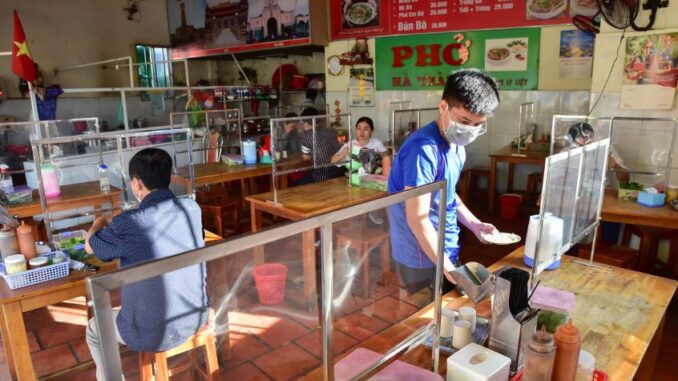
The restaurant made a partition, arranged tables and chairs to serve customers on the first day of Ho Chi Minh City for sale on the spot, the morning of October 28.

After 5 months of stopping on-site service to prevent the epidemic, restaurants in Ho Chi Minh City are sold on the spot according to the set of safety assessment criteria in the prevention and control of Covid-19 .
At a pho restaurant on Do Xuan Hop Street (Thu Duc City), a partition against drops is installed between more than 10 tables to ensure distance. “I installed it a few days ago so that customers can feel secure when eating at the restaurant. Previously there was a maximum of 20 tables, now only half,” said Dinh Quang Hai, the owner of the restaurant.

At 7 am, Hang took her son to eat pho after many months of having to buy breakfast to go home. “The feeling of eating on the spot is still delicious, the bowl of pho is hot and always has enough seasoning to taste better than taking home,” she said.

About 12 km away, the noodle shop on No Trang Long Street (Binh Thanh District) is also busy with customers.
“Yesterday, when I heard that it was sold on the spot, I added more meat and broth. Nearly 35 years here, I’ve never been so happy to reopen the shop as today,” shop owner Le Thi Thu Van (right corner) said.

Inside the shop is about 45 m2, Mrs. Van divided into two rows of tables instead of keeping them close together as before, ensuring only 50% of the capacity is served as the criteria for epidemic prevention.

3 km away, Ms. Linh’s noodle shop opens early in the morning. The night before, she and the staff were busy cleaning tables and chairs to welcome guests. “My shop is next to the Oncology Hospital, so relatives often come to eat,” Linh said.

At another restaurant near Ho Chi Minh City Oncology Hospital, Mr. Chi Lang (owner) removed the take-out sign that had been hanging in front of the door for several months.

In addition to the shops, many trolleys, and popular sidewalk shops also started selling for customers to sit and eat.

Sitting to eat noodles at a sidewalk restaurant after nearly half a year, Mr. Thai, 30 years old, expressed excitement. “The noodles you buy to take home are cold, when you reheat them, they rot, only eating at the restaurant is the best,” said Mr. Thai.

In addition, many other shops still maintain the form of take-out and have not yet served on-site.

Many cafes in the city center are also starting to accept customers. At a cafe on Le Duan Street (District 1), staff said, only serving guests sitting outside, temporarily suspending the cold room to prevent the epidemic.
During the 4th epidemic, Ho Chi Minh City experienced more than 5 months of social distancing with different levels. After nearly a month of “opening up”, there are 9 districts and districts reaching level 1 (new normal), 12 localities at level 2 (medium risk), and Binh Tan is the only district still at level 3 (dangerous). tall muscle).
According to the Ho Chi Minh City Department of Industry and Trade, the city has about 7,500 businesses and thousands of catering businesses. The form of take-away and on-site sales had to stop for many months to prevent the epidemic, causing a sharp drop in the revenue of the food industry. Statistics show that food and beverage revenue in the city in the past 8 months reached 32,075 billion VND, down 20% over the same period. Business declined, a series of food service businesses, restaurants had to close, pay ground, and reduce business. Follow vnexpress
